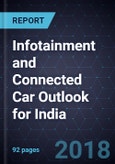Growing Vehicle Parc, Technology Evolution Inside the Car, and Increased Disposable Income to Drive the Indian Infotainment Market
The rising standards of living and a burgeoning, upwardly mobile middle class with high disposable incomes and increased Internet penetration are the key factors responsible for the growth of the infotainment system market in the Indian passenger vehicle (PV) industry. GenY, working age population, working women, and the Indian middle class continue to be the most influential segments of the population, triggering new social, technological, and economic trends. Connectivity, Digital Usage, Demographics, Vehicle Parc Growth, Technology Evolution, and Disposable Income are the mega trends driving the infotainment system market.
Bluetooth, USB/Aux, touchscreens, and the phone mirroring feature are gaining traction in the infotainment market. Lower-end passenger car and utility vehicle segments are rapidly adopting infotainment systems. The huge demand from the aftermarket (AFM) for car audio systems could eat into the shares of original equipment manufacturer (OEM) fitments in some vehicle variants due to the high costs of the car audio systems. The limited choice of car audio systems at vehicle dealerships is another major challenge for OEM fitment. OEMs will be focusing on smartphone-related technologies and OEM-proprietary software (SYNC, R-Link) to attract more customers, before upgrading to the next level.
With the increase in the number of players in the Indian PV market, there will be intense competition to capture a reasonable market share; therefore, OEMs and AFM participants are launching new models at very competitive price points. Rising digitization and greater smart phone penetration among customers is accelerating smart phone integration and syncing with car infotainment systems. Smartphone pairing features such as MirrorLink/Android auto/ CarPlay, next-gen infotainment app ecosystem (HTML/Java-based applications), as well as advanced human-machine interface (HMI) such as gesture control will soon be implemented by key OE players. The launch of entry-level sedans and sports utility vehicle (SUVs) by global major OEMs like Honda, Hyundai, Ford, and Renault has given buyers access to advanced vehicles at lower costs . OEMs in developed markets are moving from mere safety and security features to more advanced services like maintenance alerts, recall alerts, prognostics alerts, and over the air updates, which impact the total cost of ownership.
Indian OEMs are realizing that infotainment systems are becoming an important purchase criterion for the average Indian customer. The author expects that all models that will be sold in India by 2021 will at least have one variant with a touch screen infotainment system.
Table of Contents
Companies Mentioned (Partial List)
A selection of companies mentioned in this report includes, but is not limited to:
- Ford
- Honda
- Hyundai
- Mahindra & Mahindra
- Maruti Suzuki
- Tata
- Toyota
- Volkswagen
- Renault








